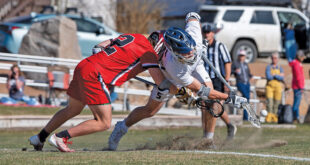“They’re just impressively efficient and fast”
It’s an entirely different world, or at least a much faster world, over in Europe when it comes to ski mountaineering, or randonnee, racing.
{mosloadposition user10}
Three local skiers—Bryan Wickenhauser, Travis Scheefer and Jari Kirkland—traveled to Andorra as part of the U.S. Ski Mountaineering team to compete in the 2010 Ski Mountaineering World Championships last week.
It was the third time a U.S. team headed to the world championships, the second time for Wickenhauser and the first time for both Kirkland and Scheefer.
In the end, the U.S. team cracked top 10 in the overall finals for the first time placing ninth among 23 nations.
Furthermore, U.S. team member Monique Merrill, who crushed the women’s field and most of the men’s field at the randonnee race here in Crested Butte, finished ninth overall among the women with strong showings in three of the four races.
“She was the highlight for the team overall,” says Wickenhauser.
As far as the level of competition, Wickenhauser explains it like this.
“Think of an elite mountain runner, who can also ski down,” says Wickenhauser. “They’re just impressively efficient and fast.”
As far as the intensity level, Wickenhauser says, “Seventy-six guys are fighting for all 76 spots. You’re fighting some Slovakian for 47th place.”
“It’s a whole different ball game over there,” adds Kirkland.
The week started with a vertical climb race, 2,800 feet up from start to finish. Scheefer sat out that day and watched while Kirkland and Wickenhauser pegged it to the top.
Heading into the opening race Kirkland had one simple goal in mind for her first international race.
“I knew it was going to be way faster than I could keep up with, I just didn’t want to be last,” says Kirkland.
Kirkland finished the day in 23rd out of 39 women and Wickenhauser took 61st out of 82 racers.
“It relieved a lot of stress for me after that race,” says Kirkland.
The next event for athletes was the individual race. Due to weather the course was shortened to 4,300 vertical feet total with four climbs and four descents including a boot pack section where skiers were required to wear crampons.
Scheefer took 52nd place in his first international race, Wickenhauser sat the individual race out.
“The courses are really different over there,” says Scheefer. “It would be like going out in the Crested Butte backcountry and bagging three different peaks.”
Kirkland rebounded back and forth in the 20’s, climbing like a fiend but losing spots on the downhill portions.
“I can honestly say I pretty much suck on the downhill,” says Kirkland.
Kirkland cracked top 20 on the first climb, fell back to 29th after the first descent and then would pass more on the way up and then lose spots on the way down eventually finishing in 29th place.
“I felt really strong with my endurance but was frustrated with my lack of ability on the downhills,” says Kirkland. “That was a huge wake-up call for me.”
Race number three of the week was a team race where athletes pair up for 7,800 vertical feet of climbing and descending, including a 3,000-foot climb on the second section of the race.
Scheefer teamed up with Max Taam to take 23rd place with a time of two hours, 50 minutes and 46 seconds while Wickenhauser skied with Jared Ignoue to take 29th place in a time of three hours and one minute.
Kirkland joined up with Nina Silitch to place 10th in a time of three hours 40 minutes and 55 seconds.
“We had a great race,” says Kirkland. “She had to wait for me on the downhills and I towed her on the uphills. It was crazy but awesome.”
To put it in perspective, the top men’s team finished in a time of two hours and 14 minutes with the first-place women’s team posting a time of two hours and 55 minutes.
The worlds closed with a three-person team relay race that was transition-intensive. Essentially, skiers switched from climbing to descending five times during an all out sprint that lasted less than 20 minutes.
“It’s all about transitions,” says Kirkland.
Both Scheefer and Kirkland were inspired by their first international randonnee racing experience.
“I can’t wait to go back—it was awesome,” says Kirkland. “It was humbling to see these athletes. They’re so flawless and smooth.”
“It got me fired up,” says Scheefer. “I probably learned more there in a week than I learned racing here in a year and a half.”
After competing twice on the world stage, Wickenhauser sees it like this for the American racers.
“We’re young,” says Wickenhauser. “It’s a progression and we’re just the sacrificial lambs for that progression.”
Next up for the three racers: the Elk Mountain Grand Traverse.
“This was perfect training for the Grand Traverse,” says Kirkland. “16,000 vertical feet of racing over a week.”
 The Crested Butte News Serving the Gunnison Valley since 1999
The Crested Butte News Serving the Gunnison Valley since 1999
